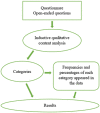Aging engineers' occupational self-efficacy-a mixed methods study
- PMID: 37275701
- PMCID: PMC10233145
- DOI: 10.3389/fpsyg.2023.1152310
Aging engineers' occupational self-efficacy-a mixed methods study
Abstract
Introduction: Engineers' work has become more complex with increased demands in today's changing working life. Self-efficacy is essential to successfully adapt to work-related changes and to cope with adverse job demands. However, less is known about aging engineers' occupational self-efficacy. Therefore, this study explores facilitators and barriers to aging engineers' occupational self-efficacy beliefs to continue working until expected retirement age. An additional purpose is to explore if any of the aspects described by the engineers are more prominent.
Methods: The study design was exploratory, using mixed methods with a qualitative to quantitative approach. A total of 125 engineers, aged between 45 and 65 years, answered two open-ended survey questions about what positively and negatively affect their occupational self-efficacy beliefs to continue working. First, data was analyzed using an inductive manifest qualitative content analysis. Next, descriptive statistics were performed based on the results of the qualitative study.
Results: The analyses revealed that health and working conditions that affect health were crucial facilitators and barriers for the aging engineers' occupational self-efficacy to continue working until expected retirement age. Furthermore, the engineers emphasized competence, motivation from meaningful tasks, family and leisure, and private economy.
Discussion: The aging engineers' own health seems to be prominent in their self-efficacy regarding a full working life; consequently, support still needs to address issues affecting health.
Keywords: aging workers; engineers; full working life; mixed methods; occupational self-efficacy; personal resources.
Copyright © 2023 Wallin, Fjellman-Wiklund and Fagerström.
Conflict of interest statement
The authors declare that the research was conducted in the absence of any commercial or financial relationships that could be construed as a potential conflict of interest.
Figures
References
-
- Antonovsky A. (1979) Health, stress and coping. Jossey-Bass: San Fransisco
-
- Bakker A. B., Demerouti E. (2018). “Multiple levels in job demands-resources theory: implications for employee well-being and performance” in Handbook of well-being. eds. Diener E., Oishi S., Tay L. (Salt Lake City: DEF Publishers; ), 1–13.
-
- Bakker A. B., Van Veldhoven M., Xanthopoulou D. (2010). Beyond the demand-control model: thriving on high job demands and resources. J. Pers. Psychol. 9, 3–16. doi: 10.1027/1866-5888/a000006 - DOI
-
- Bandura A. (1997) Self-efficacy: The exercise of control. W. H. Freeman & Company: New York
LinkOut - more resources
Full Text Sources




